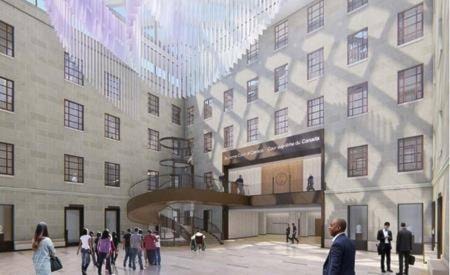OTTAWA — They say justice must be seen to be done, and that should become a little easier in the Supreme Court of Canada’s temporary new home.
A few years from now, visitors to the renovated West Memorial Building in Ottawa will enter a grand hall featuring a large skylight made of glass and steel.
A winding staircase will lead up to the courtroom, where nine angled arches — representing the number of judges — allow natural light from above to enter through glazed openings.
The building is slated to accommodate the Supreme Court for five years beginning in 2023, while the high court’s venerable permanent home, just across the street, undergoes a badly needed renovation.
Previously unseen elements of the West Memorial Building project are included in recent filings with the City of Ottawa by Moriyama & Teshima Architects and Kasian Architecture Interior Design and Planning.
The building, part of Canada’s main Second World War memorial, was constructed in the 1950s but has sat vacant since 2008 due to its poor condition, including the presence of hazardous materials.
Public Services and Procurement Canada says the building’s location, prominence and 20,000 square metres of usable space make it a suitable place to host the high court for a time. The goal is to create a modern workplace that meets health, safety and environmental standards.
The effort to make provisional digs for the Supreme Court has been overshadowed by the mammoth refurbishment of nearby Parliament Hill that has seen relocation of the House of Commons and Senate chambers to separate buildings.
The West Memorial Building, constructed of limestone, granite and bronze, is linked to the twin East Memorial Building by the Commemorative Memorial Archway, which overlooks a stretch of greenspace in the heart of the parliamentary precinct.
A new main entrance to the West Memorial Building, with accessible ramps, glass guardrails and planters, will create a terrace below the west end of the archway and connect historic Sparks Street with Confederation Boulevard.
The planned grand hall, for activities ranging from school tours to receptions, will include a stylized curtain hanging from an upper floor to ensure sound travels efficiently.
“The new acoustic feature adds a softening element in the space that is surrounded by stone surfaces and helps diffuse the daylight into the space, bringing a play of light and shadow,” the architectural documents say.
The courtroom will be a bit bigger than the current one, with the judges seated on a “slightly elliptically shaped bench” on a dais backed by a wall of natural stone.
“The design needs to visually and experientially communicate the pre-eminence of the Supreme Court of Canada while embodying its fundamental values of equality and justice for all Canadians,” the project’s design brief says, acknowledging the difficulty of doing both at once.
As in the existing Supreme Court building, there will also be rooms for Federal Court proceedings.
The government is touting the environmentally friendly aspects of the project, including a green roof with plants that can regulate temperatures and save energy.
The exterior will also see the addition of stone planters and seating areas, for both comfort and as a security feature for protection from approaching vehicles.
A budget of more than $1 billion has been earmarked for renewal of the West Memorial Building and the Supreme Court building, which has not been extensively updated since its completion 80 years ago.
Once the Supreme Court’s permanent home is renovated, the West Memorial Building is to become long-term office space for federal agencies again.
